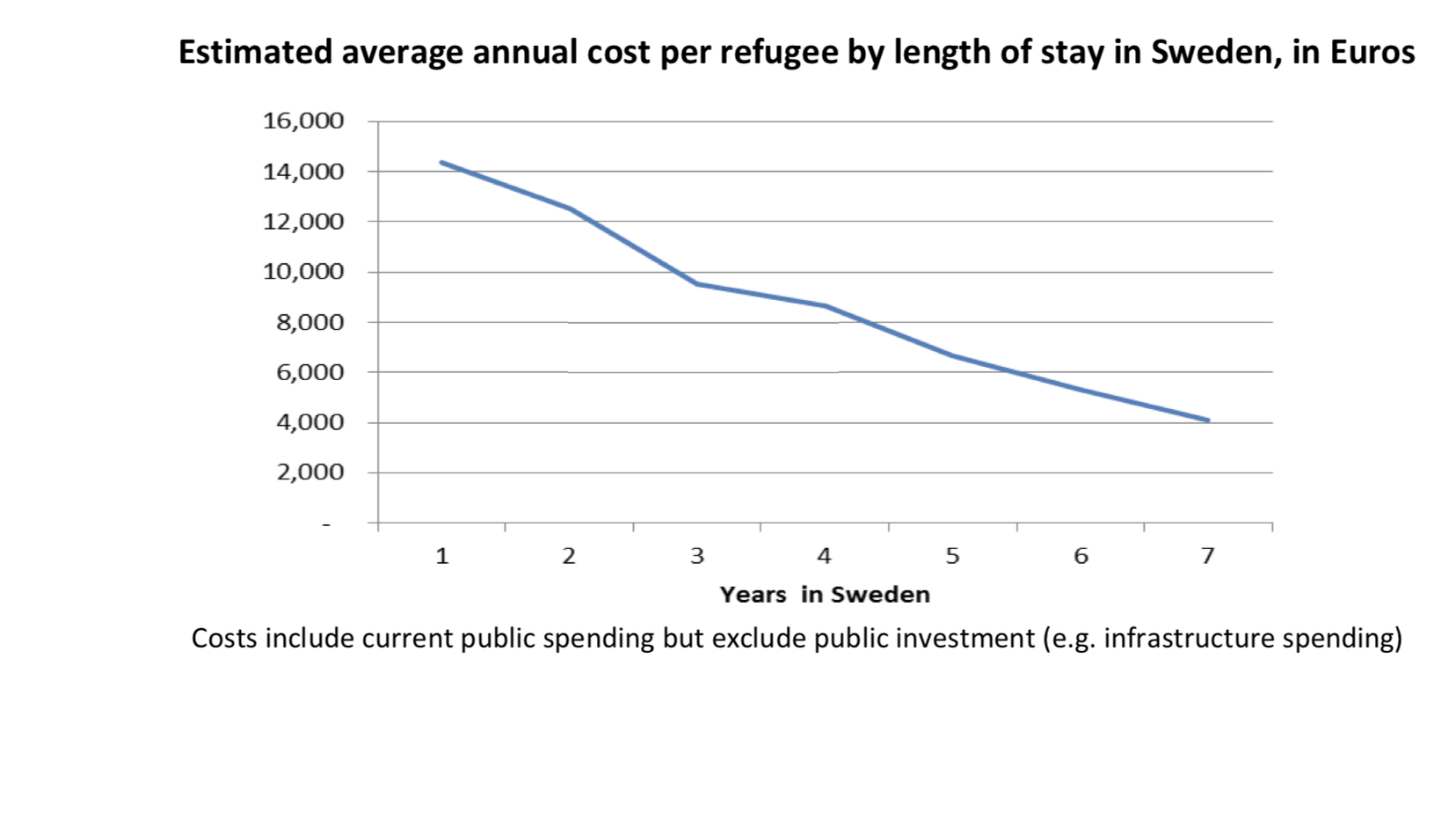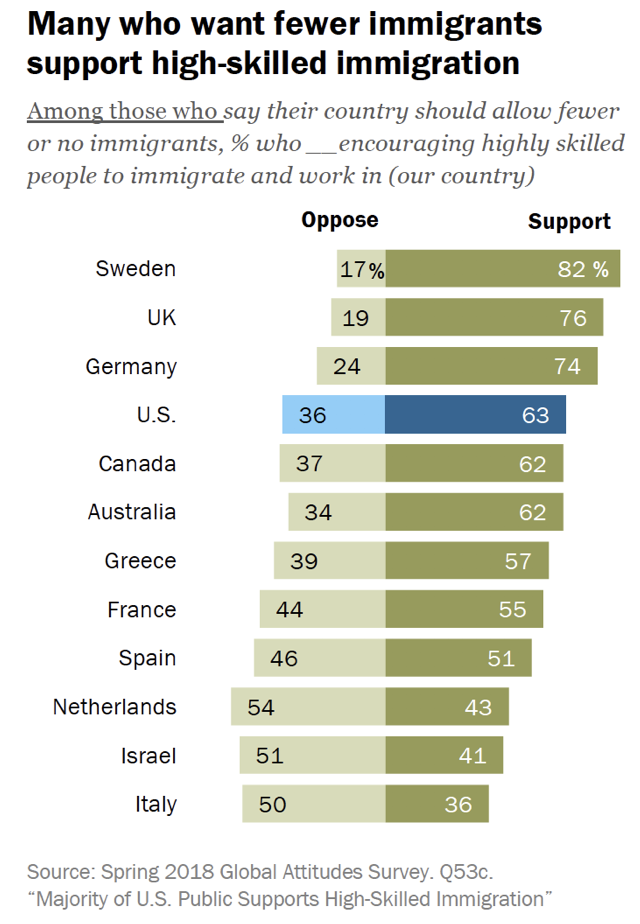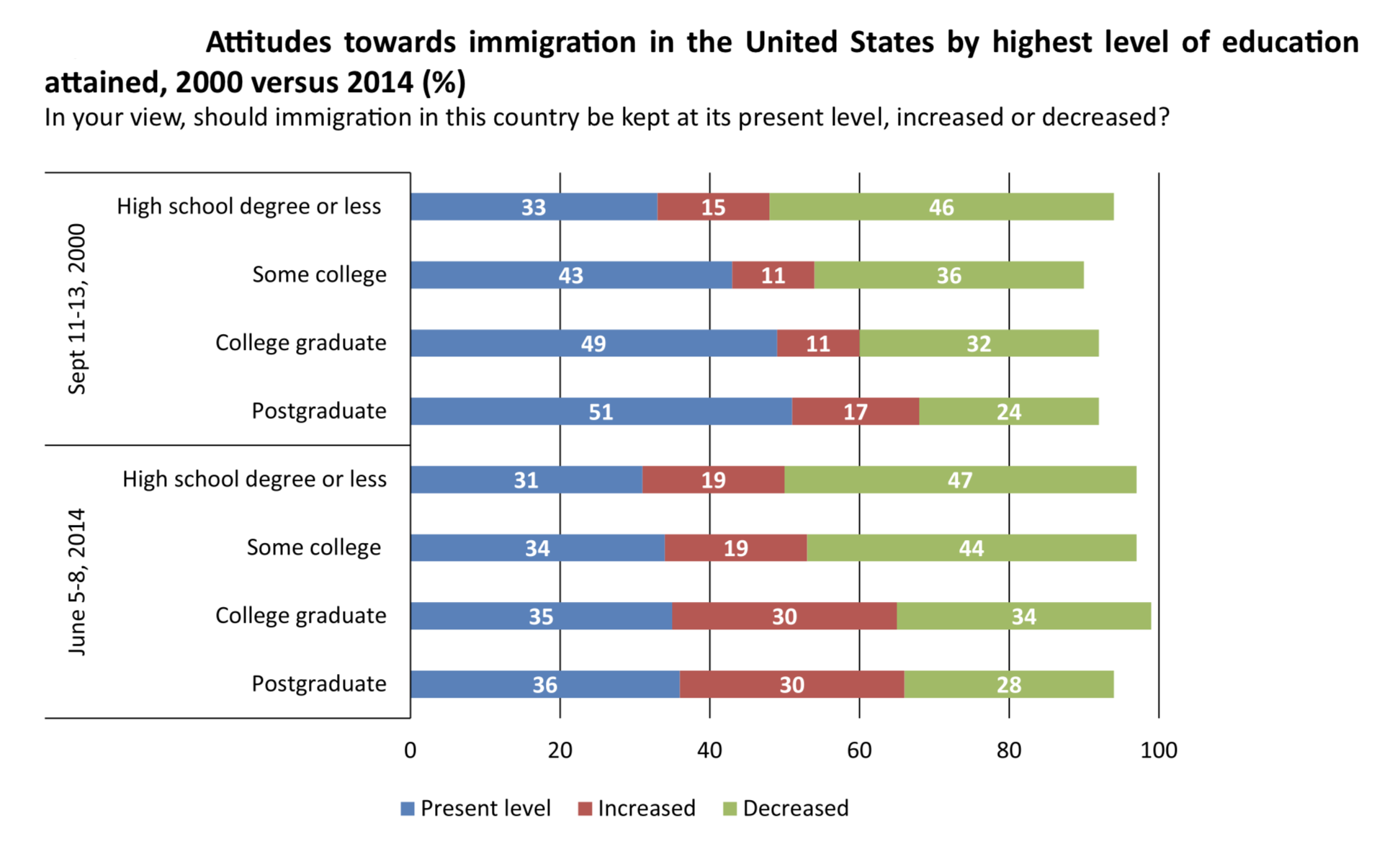The time has already come when each country needs a considered national policy about what size of population, whether larger or smaller than at present or the same, is most expedient. And having settled this policy, we must take steps to carry it into operation. The time may arrive a little later when the community as a whole must pay attention to the innate quality as well as to the mere numbers of its future members.
Certainly there were found among his listeners some, who in the last few years were driven out of the land in which they had worked and lived; and many, who wish to emigrate from an overpopulated Middle Europe and cannot, because the workers of more thinly settled lands defend themselves against the addition of competitors.
IMMIGRATION COSTS AND BENEFITS
Economic theory postulates that there are limited resources and unlimited needs. It thus seems logical, at first glance, that immigration should be of benefit to the hosting country, as it implies added human resources, and thus a higher production level.
There are however a number of false assumptions and fallacies within this deceptively simple argument. First, of course, it is not clear if the goal of a society should be to have the highest level of production. The inflow of immigrants can have other consequences, both positive and negative, beyond its economic impact. Second, even if production or wealth should be optimized, should it be per person in a given country or the total aggregate number? Letting in poor immigrants might well increase a country’s total population and production capacity while also decreasing the level of wealth generated per person. Lastly, immigrants will have needs – including drawing on public benefits and infrastructure – and those should be accounted for.
Indeed, it is not clear that an immigrant would necessarily create a net benefit, even if he is working. Especially in countries with advanced social security, immigrants are given a number of economic advantages just by the simple fact of their presence. First, they are given access to a number of public goods, such as transport facilities, utilities, and infrastructure. Second, they are given access to publics services, which can include health care and education at no cost. Lastly, they often receive direct financial support, such as subsidized housing, unemployment benefits or child benefits. National Academies Press
Maurice Allais, a French Nobel laureate, estimated that the collective infrastructure investment necessary (the building of roads, transport, hospitals to keep at par with the increased population) for an immigrant to be roughly equivalent to his first five years of income if he is alone, and twenty years if he has a wife and three children. The costs of these public goods will obviously depend on the host country. For instance, if a host country has a declining population, the collective infrastructure investment could be somewhat lower, even if it would still need to be constantly maintained and modernized, for it may have some spare capacity. Similarly, in a country with little or no infrastructure, public service, and financial support, the cost of immigration will necessarily be smaller – and its potential positive impact higher. Allais
Sweden’s Fiscal Council estimated that for the first seven years, the cost of public spending per refugee starts at about 15,000 euros and declines to about 4,000 euros by the seventh, with a cumulative cost of roughly 60,000 euros over that period (assuming the assimilation is successful and the new immigrants gradually integrate and contribute over the years). That estimate excludes any of the public investment or infrastructure spending (use of public goods). On this basis, the cost of an immigrant family with three children over seven years in public services and benefits would be about 300,000 euros. It is estimated than in the last few years, Sweden has taken in over 600,000 migrants.29 Similarly, in a less generous social welfare set-up, the Australian government estimates that the net fiscal impact of a refugee is over 12,000 Australian dollars in the first year, declining to a few hundred dollars by the 10th year OECD.
Whatever the true costs incurred by the collectivity in absorbing a migrant wave, from having to invest in new infrastructure, expanding services, or providing financial support, it is clear that should an advanced host country want to maintain a uniform access to public services, the sums involved will be significant and far exceed the economic contribution that can, for many years, be expected of the new residents. The corollary is of course a tremendous economic gain for migrants from low income countries, easily exceeding a lifetime’s income in their native country.
Consider for instance that the annual GDP-per-inhabitant in Syria is slightly below 2,000 euros. Migration thus acts as a strong rational attractor for migrants from lower income countries, one that is only compounded by the “push” factors of political turmoil and armed conflict. The bottom line is that for lower-skilled immigrants with large families, the costs incurred by the collectivity will be far higher than the tax that can be collected directly and indirectly from their additional economic activity over many years. It is a large subsidy to the migrant, especially in light of their lifetime economic prospects in their home countries.

WINNERS AND LOSERS
What is less obvious is who are the winners and losers of these immigration movements within the host country. Immigration supporters are generally found among the higher income and higher-skilled, as well as companies or entrepreneurs from labor-intensive industries that rely on low skilled labor. Both, beyond any moral motivation they might also have, definitely have an economic incentive to favor mass, low skill immigration. Both benefit from an increased supply in low skill labor.
When low skilled immigrants flood a labor market, it makes high-skilled workers rarer as a share of the total workforce, increasing the ratio of low skill to high skill workers. This benefits high-skilled workers by improving their relative position in the marketplace, increasing their bargaining position and raising their incomes. In Germany for instance, polls reveal that the highest income quintile is about 30% more in favor of immigration than the lowest income quintile. An even better predictor of one’s attitude towards immigration is education. The highly educated systematically favor more low skill immigration, which naturally improves the relative rarity of their sought-after qualifications. In the U.S., people with postgraduate degrees are 40% less likely than those who hold a high school degree or less to favor a decrease in immigration.
Similarly, labor intensive industries, such as agriculture, where harvesting becomes significantly cheaper with the availability of a cheap, low skilled labor force, support immigration. New supplies of cheap labor allow business owners to postpone costly investments in mechanization, pay lower wages, and continue activity that may otherwise have to be discontinued as non-competitive. The extra workers act not only as a source of new supply, but as a control on the prevailing wage, thwarting demands from native workers for wage increases. This of course disproportionately affects the less skilled workers of the Western world.
I remember watching a game show on British television around 2010 where candidates from various backgrounds were asked their opinions on immigration. Among the five or six candidates vying to attract attention, only one dared to say that there needed to be a stop. It was a young British woman of Somali origin. She said the misery in Africa was too great for England to absorb, and that it just did not have the means. She said she feared that if it was not stopped it would deprive her and her community in East London of being taken care of until they could reach a certain level of self-sufficiency, properly integrate, and fully contribute. It simply was not possible she said. Another contestant, an elderly British gentleman who had previously stated we should be more open and generous, paused. He was surprised, he said, for he had never thought about it this way.
A Brookings review of studies on the effect of immigration on wages in the U.S. found that there is no material change overall due to immigration. However, there are also signs that displacement of lower-skill Americans due to competition from immigrant labor is taking place, which impacts their earning power. One study puts the effect of immigration at close to a 5% decrease in wages for Americans with no high school diploma, although other studies claim the effect is much lower Brookings CIS.
The population that loses out the most, and is thus most hostile to immigration, is the working class, with whom migrants compete. Migrants accounted for 47 percent and 70 percent of workforce growth in the U.S. and Europe, respectively, over the last 10 years. But, in Europe, only 14 percent of the increase in the high-skilled workforce came from immigration. That is, while the high-skilled have benefited, the low- and medium-skilled population has had its earnings ability capped, or even lowered, because of greater external and internal competition Elias Naumann OECD.
The locally established low skill population rightly recognizes the new entrants as competitors. Their economic prospects will be negatively affected on the one hand, while on the other, resources dispensed through the state from which they benefit will have to be shared among more people. Indeed, a majority of those opposed to immigration are in fact in favor of high skill immigration. This makes sense as the new high skill immigrants are expected to be net contributors and thus not an economic drag or competitor for the lower skill native population Gallup PEW.
Another exception to working-class opposition is if the new migrant wave has a high cultural affinity with some prevailing segment of working-class inhabitants, especially if it is distinct from the rest of the population. In that case, the increase in the numbers of people with that particular affinity make it rational to support migration if it will improve the collective bargaining position of the combined pool of migrants and likeminded working inhabitants. Their ability to claim particular political rights or representation will be increased, translating into political handouts. They can then hope to collectively obtain specific public goods, services or benefits they may not have had otherwise. In the U.S., for example, Hispanic workers are more likely to support immigration than their white counterparts.


WHICH IMMIGRATION
An honest debate about immigration should start with objective measurement. Beyond the cost, one has to recognize the importance of a country’s human resources. When one bright doctor leaves the country and an unqualified agricultural worker enters, we are today told that the population is stable. In fact, the human capital of the country, in this example, has been severely diminished, for it takes years of training a gifted individual to produce a doctor. Just as we keep track of trade balances, we need to begin tracking human capital balance, for in the long term it is at least as important.
On this basis, one obvious answer to immigration, as already implemented more or less openly by a number of countries, is to make human capital a factor in who gets in. Countries like Canada, the U.S. or Singapore have put explicit models in place, more or less efficient in measuring this effect, to promote the import of talent. This is not an easy task, for a bright student may not have any degree or fortune but a high talent potential. Thus, high-skill import requires a dynamic view of a human being’s capability over time. The corollary is of course that low skill immigration must be somehow deterred, for what is the purpose of promoting talent import if it is swamped by a larger untalented pool?
Immigration deterrence is a difficult subject from a human point of view, for there are only two alternatives, both of which pose ethical issues. The first, of course, is forced deportation and the reinforcement of control, including the potential erection of physical barriers in some cases. For all his political posturing, Donald Trump may well be onto something with his stubborn insistence on building “The Wall,” as difficult as this may be for U.S. elites to admit. The second is to treat people differently according to their immigration status.
This is of course always the case to some extent, but Western democracies have a fundamental tendency to equalize rights over time. For instance, free health care is often provided to illegal immigrants, as is free education to undocumented children. While this is consistent with Western values, it does not come free, and it provides a strong incentive for migrants to come – in practice, to come illegally – as these services are costly and simply not available in their native countries. There are countries – such as Italy, where some of these services are denied to illegal migrants, and this unsurprisingly acts as a strong deterrent.
Ultimately, what this means is that the concept of universal social security, of universal education, and free public services is incompatible with open borders and free migration, for the attraction effect is just too material and will inexorably lead to massive waves of low skilled migrants. Here we see a similar trend to that observed in recent decades in trade, where the cost of transport has fallen so much that it has significantly expanded the volume of economically viable cross-border commerce. The availability of information in poor countries on the situation in potential host countries and the benefits they can expect to receive once safely inside them, along with the increased ease of travelling, have made migration easier and more common. These waves will de facto make the level of public services currently provided for all unaffordable and a thing of the past.
Setting aside any Western countries possible responsibility in creating emigration through unwise intervention and meddling or any consideration for a ‘war of civilization’, a rational debate can no longer be avoided. Western societies have to make a painful moral choice. They can continue to provide an internal safety net for all inhabitants by rejecting low skill migrants and enforcing deportation. Or they can accept there will be two classes of citizens that will be treated very differently and fundamentally renounce the universality of social protection and basic public services. This is a choice that states should have made clear to their electorates long ago but have preferred to ignore as elites have racked up the short-term gains of an unsustainable status quo. Ignorance cannot remain bliss forever, and the choice is only becoming harder the longer it is deferred.